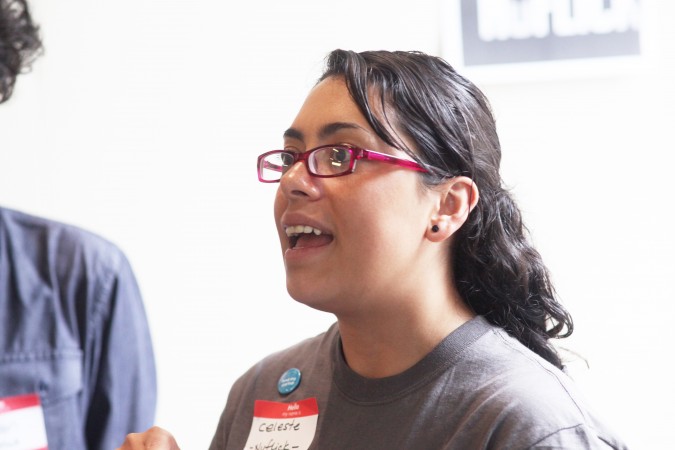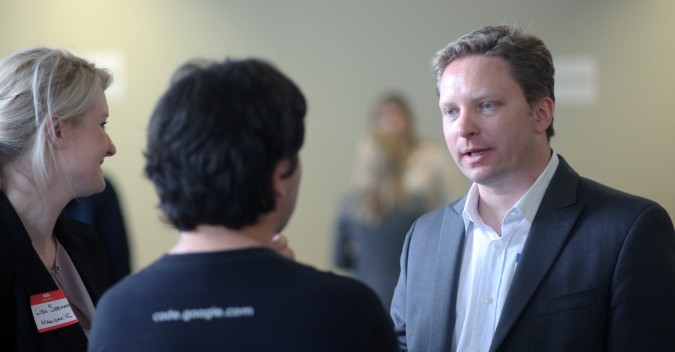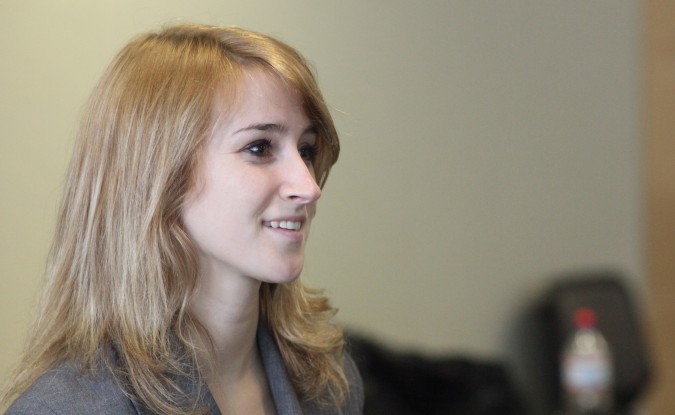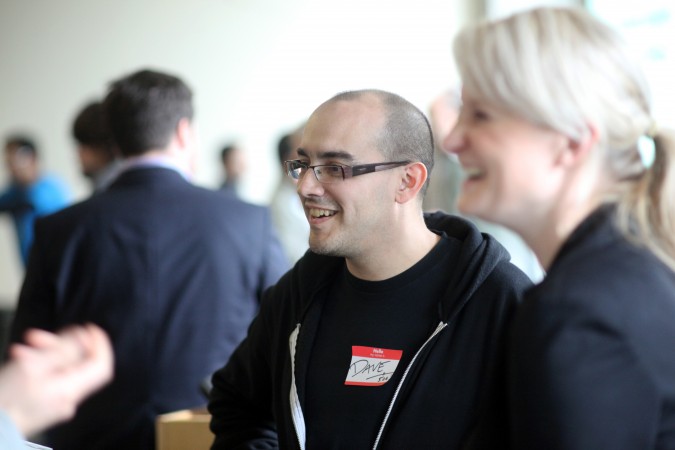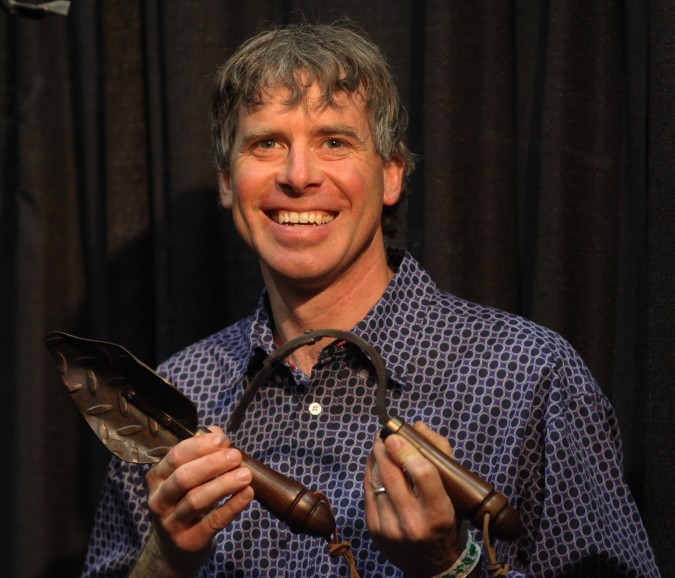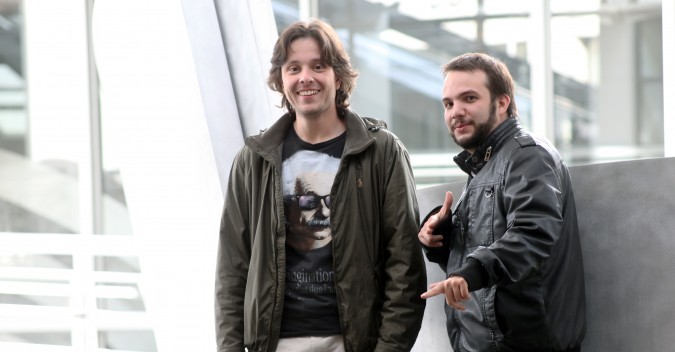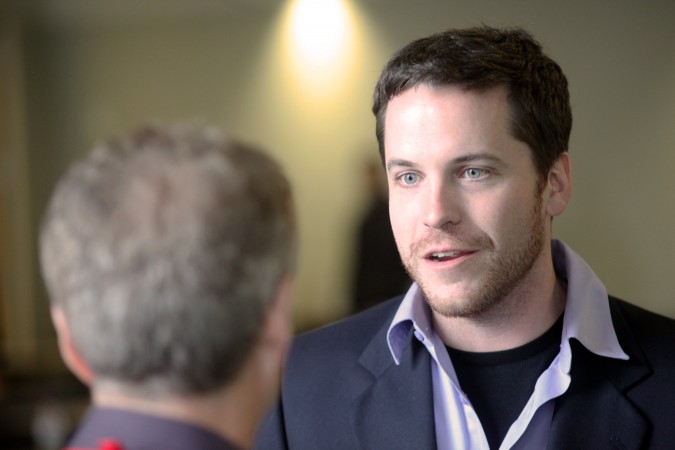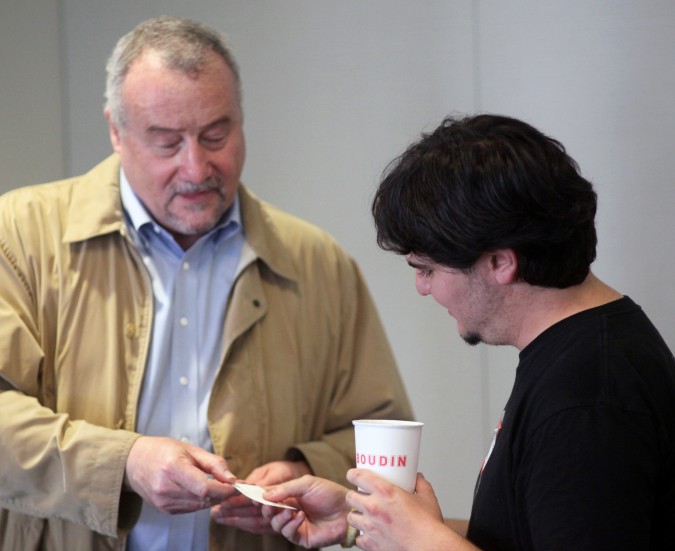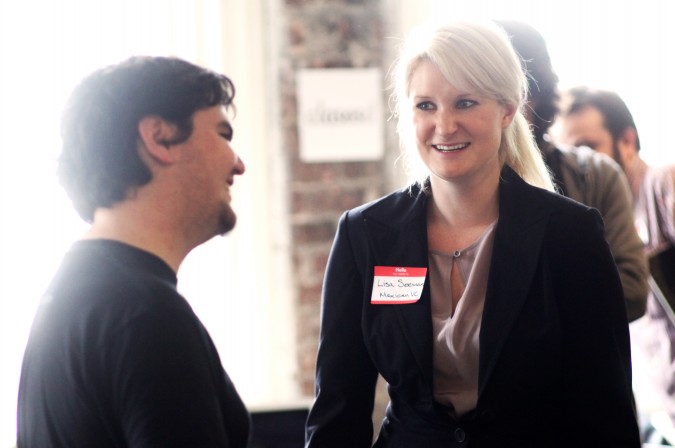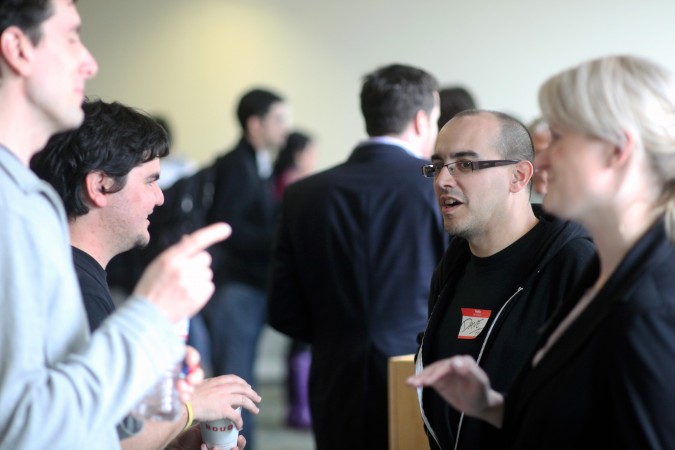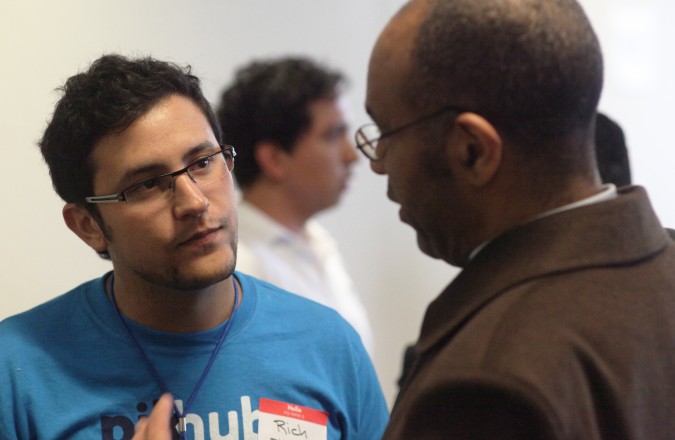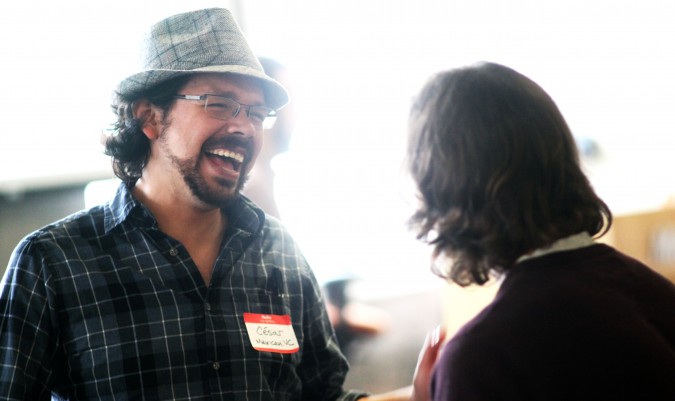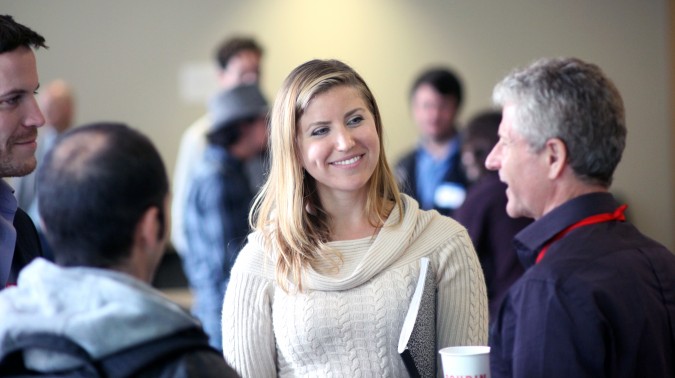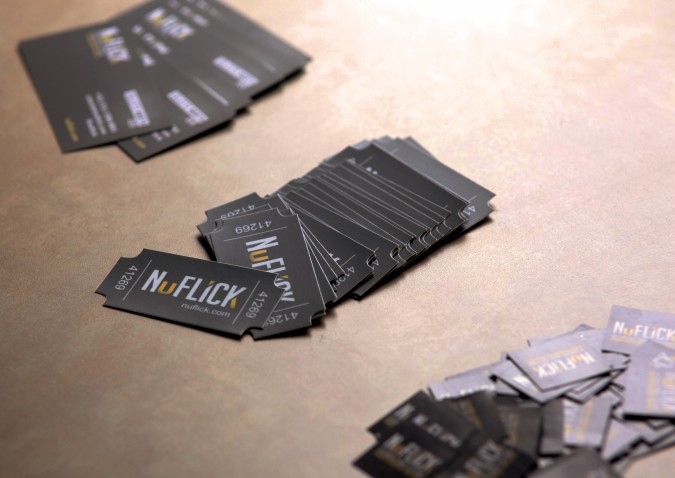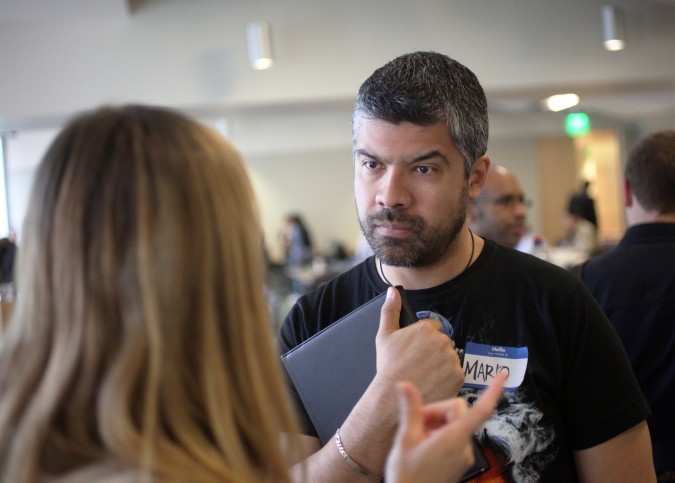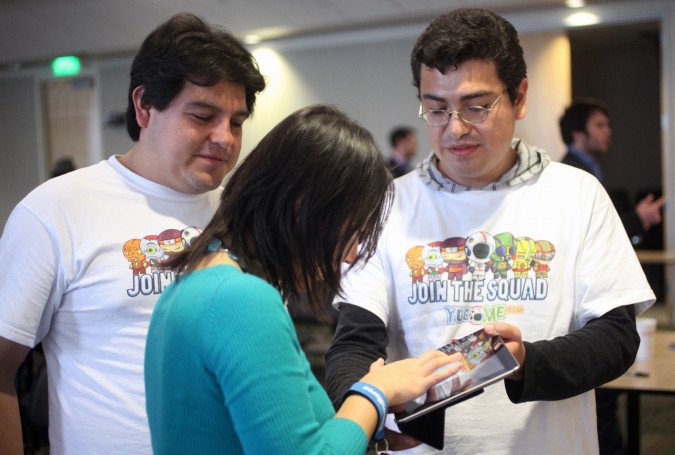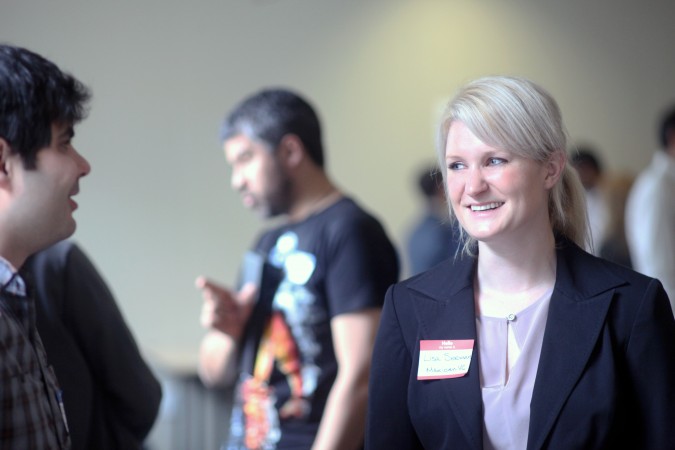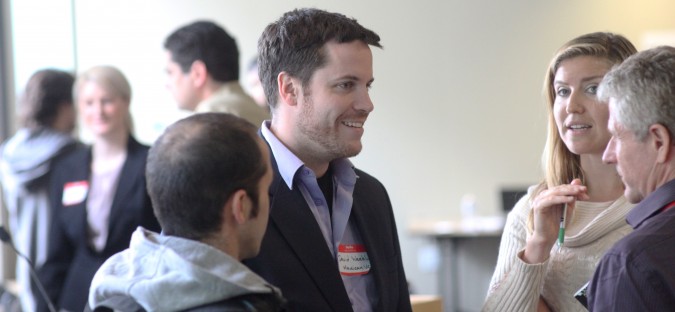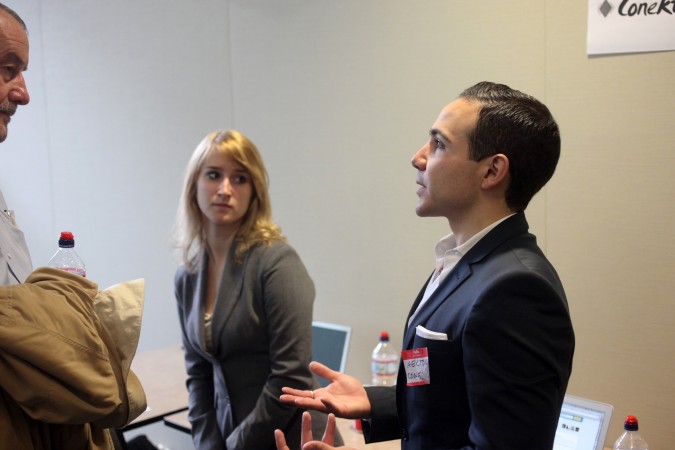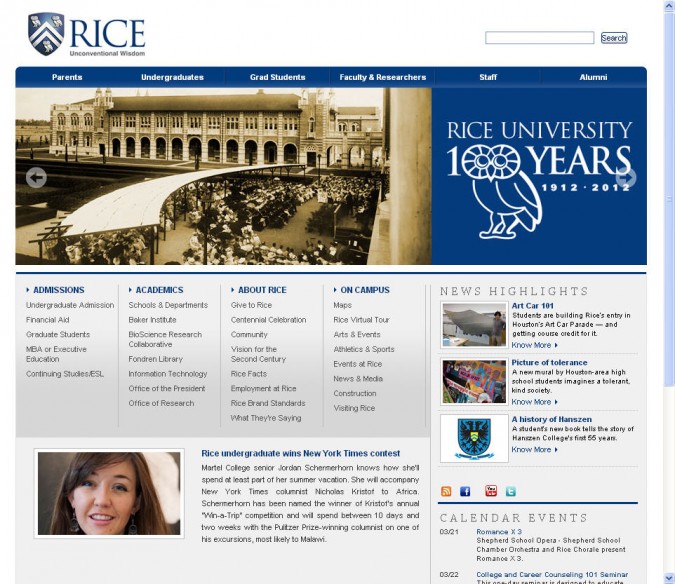Archive for March, 2012
mexican.vc Demo Day startup pitches, March 16, 2012
On March 16, 2012 I attended the first Demo Day for Internet startups funded by the new venture capital firm mexican.vc. I wrote a blog post that night about the very exciting event. I also wrote a separate post about ClasesD, the only one of the seven startups that I missed interviewing on Demo Day. Finally, I wrote a post showing the very impressive demo Manolo Diaz gave me of Trash Chaos, one of the top educational games on the Apple iPhone and iPad App Store.
Today I present what will likely be my final post on this Demo Day.
I captured video at Demo Day of the startup pitches. Prior to the start of the pitches, I had asked for and received permission from mexican.vc General Partner Santiago Zavala to take pictures and blog about the event.
I forgot to explicitly ask for permission to capture video, so I have been reluctant to publish this video.
Thankfully, yesterday, I asked another General Partner, David Weekly, if it would be alright to publish this video, and happily, he gave me permission, with enthusiasm.
San Francisco Flower & Garden Show, March 24, 2012
On Saturday, March 24, 2012, I attended the San Francisco Flower & Garden Show at the San Mateo Event Center in San Mateo, California USA.
I met Tuli Fisher, the owner of Fisher Blacksmithing at 409 South Fifth Avenue in Bozeman, Montana 59715 USA. Fisher personally crafts the nicest hand garden tools I have ever seen. That’s right, he hand-forges the iron parts for the hoes, trowels, rakes. He turns the handles on a lathe. He occupies the booth at various shows, where he personally sells his quality product. Fisher graciously posed holding two of his fine creations, above. I photographed three examples of his work, immediately below.
Here’s a piece about Fisher Blacksmithing that appeared on Forbes.com. In 2009, Fisher Blacksmithing was featured on the cover of Bozeman Magazine, the city in Montana where Fisher lives.

Fiesta Roses from FiestaRoses.com, on display at the San Francisco Flower and Garden Show, March 24 2012
These roses are ‘real’ in that they were living before being cut. They are called Rainbow Roses, and you can order them at FiestaRoses. I had never seen these before, so I inquired about the process. Here’s what the website of the manufacturer says:
1. Fresh long stem [white I was told] roses are hand picked from our farms to make our Rainbow Roses
2. A trained horticulturist prepares the roses for “fiesta-ization”.
3. The roses are placed in a unique substance, which is a combination of water and various dyes. The roses slowly absorb the dyed water the same way as they would naturally absorb water. Our unique process allows the horticulturist to pinpoint which petals receive each color of dye. This results in the various colors being diffused throughout upwards of 60 of the rose petals thus resulting in rainbow roses, blue roses, purple roses.
4.Rainbow roses, Blue roses, Purple roses are carefully packed and shipped throughout the United States.
Here’s a video clip I shot that shows the main building for the show. These exhibits were elaborate, and at least one had a fish pond with large live fish in it.
I posted these pictures at full camera resolution of 21 megapixels. Click on them to see the full size versions.
Trash Chaos iPad and iPhone children’s educational game demonstrated by Yogome.com co-founder Manolo Diaz
When I was at the Demo Day a week ago for the first graduating class for mexican.vc, I got to meet Manolo Diaz, a co-founder of Yogome.
mexican.vc is a seed stage venture capital firm that invested in Yogome. I was at the Demo Day because I know one of the people at mexican.vc.
Yogome makes educational software for the Apple iPad device and the Apple iPhone smartphone. Yogome apps are games that educate. They are fun, beautiful and engaging. If I had an iPad I would download them.
Diaz was kind enough to demonstrate the game Trash Chaos, which requires students to sort trash they see on the ground into the proper recycling bins. As students get faster and more accurate, more trash appears, as do more recycling bins.
I put Diaz on the spot by proposing he demonstrate Trash Chaos while I captured video. The room was filled with people talking, but Diaz still put on a great demo that’s articulate and approachable. I present the full unedited demo above.
Diaz gave me a Yogome large size t-shirt to give to a lucky reader of my blog.
I haven’t given anything away on my blog before, so this is exciting.
What I’m going to do is mail the brand new shirt with the tags still attached to the first person to Tweet this blog post to at least 100 of their followers. Alert me that you have done this by leaving me a comment here with your Twitter handle. You can be anywhere in the world, and I will pay the postage to send the shirt to you. Remember, it’s a men’s size large, not a children’s shirt.
Trash Chaos was the number 10 Apple App Store app in its category of free educational software on March 16, 2012, the day I made the accompanying video.
Great job Yogome!
ClasesD is SkillShare.com for Mexico
On Friday, March 16, 2012, I attended the first ‘graduation’ of the first ‘class’ of companies funded by the new seed stage venture capital firm mexican.vc. mexican.vc is run by four sharp General Partners — David Weekly, Santiago Zavala, Lisa Seeman and César Salazar.
mexican.vc has signed up prominent mentors to help, including Dave McClure, the founding partner of 500 Startups.
After the presentations, the teams dispersed around the conference room at Microsoft’s office at 835 Market Street in San Francisco, California USA. There were seven teams altogether. Three of the teams were set up along the left wall and three of the teams were set up against the right wall.
I introduced myself to and interviewed all those teams on Friday, and I wrote a long blog post about them that night.
What I didn’t know at the time was that the seventh team had set up their station up front in the room, where there was not a table, but a podium. That arrangement never registered with me that day, even though I had several lengthy conversations with people by that podium after the presentations. I didn’t know a team was there engaging with attendees. So that team, ClasesD, missed out on the commentary I wrote for my Friday blog post.
I was upset that I missed a team, so I wrote in that Friday post that I was willing to meet with the team I overlooked. The team found my blog post and reached out to me via my Facebook page.
I met the team yesterday afternoon, March 18, 2012, and we had an enjoyable meeting at the San Francisco Main Branch library at Civic Center in the City. I signed out one of the glass work rooms on the 4th floor so that we could talk without disturbing others.
Luis Enrique Aguilera and José Eduardo González described their company to me, and I had time to ask questions.
Before I get into my remarks, here is what the website for mexican.vc has to say about ClasesD:
“Interested in learning Spanish? Want to take yoga during your lunch break? You are in the right place! ClasesD is a marketplace for in-person lessons taught by independent professionals. Earlier this year when founder Eduardo was looking for dance lessons for his sister, he realized there must be a better way to advertise classes than flyers tacked on corkboards around town. Now, his team is helping people craving for knowledge find the right tutor in their city.”
Here are my comments about ClasesD:
ClasesD is SkillShare for Mexico. This is my observation, not something I heard from Aguilera or González. SkillShare is based in New York City, USA, and they have raised millions of dollars to pursue their business.
Although comparisons to airbnb have grown somewhat tiresome, such a comparison to ClasesD is inevitable. airbnb turned everyone that’s not homeless into a potential operator of a bed and breakfast. SkillShare and ClasesD turn everyone into a potential operator of a one teacher school.
If you’re a good cook, musician, painter, photographer, writer or mathematician, you can list your qualifications on ClasesD by creating a profile. Potential students can browse listings and read about the widely varied offerings. Of course, classes can be about anything, not just the example subjects I listed in this paragraph. Teachers set their own prices.
Students indicate their interest in a class and then the ClasesD website connects teacher and student together by telephone. This gives the teacher an opportunity to sell themselves to the student to increase the chances that prospects become customers. This highly personalized sales process might be unwieldy at scale, but I think it’s preferable in these early stages where the parties are still getting used to having an online marketplace to find each other in Mexico.
ClasesD makes money by charging a fee, currently 100 pesos (USD $7.93 at today’s exchange rate), to the teacher for providing the lead. Teachers keep all of the fee that they charge to attend their classes.
mexican.vc graduated 7 teams on Friday, including Fontacto. As I wrote in Friday’s post, Fontacto is Ring Central for Mexico. Fontacto helps small organizations appear big by offering a virtualized phone system that in its physical version is generally too costly to purchase and install at the organization. In a bit of portfolio company collaboration that would make any investor proud, ClasesD is a savvy consumer of Fontacto’s impressive telephony services.
One of the many impressive features offered by Fontacto is the ability to set up apparently numerous extensions on one physical telephone number.
ClasesD publishes a Fontacto powered phone number for students to call teachers on. Each teacher has an assigned extension number in the Fontacto system. Student’s calls are routed to the teacher, who can answer on whatever phone is most convenient at the time, including their mobile phone or their Skype connection. All the teacher’s assigned devices ring simultaneously, I presume, since that’s one of the features offered by Fontacto, and it makes sense to enable it for this application, where the students are probably most likely to become paying students if they reach the teacher on the first attempt.
ClasesD has a chicken and egg dilema — they need lots of teachers before they can get lots of students, but it’s tough to get lots of teachers until they have lots of students.
Marketplaces such as SkillShare and ClasesD are compelling to me. The operator of the marketplace does not have to stock and finance inventory. People expect to pay for services delivered through such marketplaces. The margins can be attractive given what needs to be done to operate the marketplace.
Aguilera and González struck me as passionate and determined. They’re learning quickly, and have tested several business models already on their search for the best model for Mexico. Their enthusiasm was evident from the moment they contacted me. I am not running TechCrunch, GigaOm or VentureBeat. I’m writing a personal blog. I will get perhaps 12,000 visitors to this site this month (I had 10,321 visitors in February, 2012). I still haven’t cracked the top million sites on Alexa. This is easy for others to check out. That Aguilera and González tracked me down and patiently explained their business to me to get a tiny amount of press shows to me that they are really trying to make ClasesD a success. They are well spoken and likable guys, and I wish them all the best.
My advice to them is to find a prove a business model that works, and then raise a million or more US dollars immediately to accelerate populating the site with more teachers and students. If you don’t solve the chicken and egg problem, a competitor will spring forth to do it for themselves, using your research to move more quickly.
Here are the biographical introductions for Aguilera and González, again from the mexican.vc website:
“Luis Enrique Aguilera graduated from ITESM Guadalajara with a B.S. in Business Administration. He is an entrepreneur, creative mind, and music aficionado. He is passionate about web marketing and SEO. He previously worked as a marketing and business consultant, which taught him to create powerful and innovative business models that he is eager to apply to his own startup.
José Eduardo González graduated from ITESM with a B.S. in Computer Science. Before founding ClasesD, he worked for 2 years as a Ruby on Rails developer in a startup called Inovaz (now a 500 startups company with their product Ovia), where he got his first taste of entrepreneurship and learned agile development practices.”
Aguilera and González graciously posed for pictures at the end of our meeting. I used the photogenic interior of the San Francisco Main Branch library as the backdrop. It was fun showing Aguilera and González around the library as this was their first visit. I attended the grand opening of the library on April 18, 1996, which featured a dramatic special delivery of the door key by skydiver Carl Prigee to Mayor Willie Brown after Prigee jumped from a biplane and landed right on target in front of the library, to the applause of the thousands gathered in attendance.
mexican.vc Demo Day, March 16, 2012 in San Francisco, California USA
This afternoon, March 16, 2012, I attended the Demo Day for the first graduating class of Internet startups funded by mexican.vc.
mexican.vc is a new seed stage venture capital firm based in Silicon Valley.
mexican.vc invests only in Internet companies that reside in Mexico.
mexican.vc currently invests USD $20,000 for 15% of the startups it accepts into its highly competitive program that includes mentorship, legal work and investor introductions.
mexican.vc is not an incubator and physical space is not provided to portfolio companies.
Portfolio companies are scattered throughout Mexico, which was a surprise to the general partners that run the brand new firm.
Some 75 teams applied for funding, but only seven firms were admitted to the first ‘class.’
Today’s ‘graduation’ of the first ‘class’ was an exciting thing to watch.
I attended because I am (barely) friends with David Weekly, one of the founders of mexico.vc, and via Facebook Weekly invited his friends to attend. I signed up as a blogger and brought my Canon 5D Mark II and a tripod to the event, held at Microsoft’s San Francisco office at 835 Market Street.
As a side note, I met Weekly soon after he co-founded Hacker Dojo in Mountain View, California. Weekly is a well known and well connected entrepreneur who writes a quality blog. While I was researching this story, I discovered that on March 8, 2012 Weekly advised non-technical Internet company startup founders to learn to program. Weekly said it’s essentially impossible to recruit a good technical cofounder to your company for no pay. I wrote a strongly worded blog post on March 11, 2012 giving the same advice to learn to program. I did not see Weekly’s outstanding post until today.
In part, Weekly writes:
“Napster was Shawn Fanning’s first Windows program – he was teaching himself how to code on his uncle’s couch so the early betas had lots of atrocious bugs. The company didn’t need a longstanding Windows expert to put the tech together, it needed someone who was willing to put in the elbow grease to figure out how to do it. In other words if you’re looking for a technical cofounder consider becoming one. It’s just too hard to find random technical people who don’t know you, are highly competent, and are happy to work for no pay and very little equity on your idea. (surprise!)”
I know I am writing a post about mexican.vc and not startups generally, but this is such a great quote and such a great opportunity to print it that I couldn’t resist. Napster was one of the most significant programs of the Internet age, and I learned from David Weekly tonight that the creator of Napster was not a Windows programmer before he coded the Windows version of Napster! I don’t know if Fanning was a programmer of other languages prior to this effort. But even so, my advice and Weekly’s advice is worth listening to. Learn to program, even if you plan to be the Barista, CFO, Janitor, CEO, Office Manager or Administrative Assistant.
Your life will only improve if you can also program.
Now back to mexican.vc’s Demo Day.
Here are the summaries word for word from the mexican.vc website of the companies I saw present today.
I will indent the official summaries. Then I will write my comments on that team and their product.
What mexican.vc says on its website about Yogome:
“This small team of brilliant hackers and designers is building better educational games for K-12 children mainly on the iOS (iPhone & iPad) platform. They are partnering with educational institutions to build fun, educational adventures that help kids learn more effectively. The characters in the game are superheroes fighting against the Queen Ignorantia.”
My comments on Yogome.com:
Yogome is my favorite of the companies I saw today. Their iPhone and iPad game is gorgeous. It looks like it was designed by a large game company, not three people that have been at it just a few months. Amazingly, this game today was the 10th most popular free educational downloadable application in the Apple App Store. It’s been zooming up in the rankings, jumping over 24,000% in the last week, according to a genuine hockey stick graph the team showed during their pitch. Even crazier, their app is number one in Thailand today in the same category.
Yogome plans to continue to give their apps away for free. They will make money by offering so-called ‘in app’ purchases where an existing player can upgrade after they have already discovered how wonderful the free app is. I like this strategy.
I persuaded Manolo Diaz of Yogome to show me one of Yogome’s games while I captured HD video. He narrates as he shows how to play the game, which teaches children to recycle by having them pickup apple cores, banana peels, bottles and cups and drop them in the correct recycle bin. Speed and accuracy are rewarded, and there is educational text at the end alerting players to what they learned and why it matters. The graphics in this game are lush, polished and delightful. Students play about half an hour per session, according to Diaz, indicating the games are engaging and fun.
What mexican.vc says on its website about Cactus:
“Through their initial startup experience, the team learned the ins and outs of the restaurant industry, both from the vendor and consumer perspectives. Cactus now offers a geo-aware mobile app that grants access to discounts in a growing network of restaurants. The basic app is free, giving users instant access to thousands of discounts. Moreover, users can upgrade to a premium subscription and enjoy substantially larger savings on every affiliated restaurant.”
My comments on Cactus:
This iPhone app looks well designed and smart. It’s not a Groupon like loser. Instead, it’s a phone enabled price discount system that gives restauranteurs real time analytics at the point of sale. A customer searches through a list of nearby eateries on their iPhone. When they find one they like, they show their phone screen to the cashier or waitperson, who enters the unique code on the screen into the Cactus website. The Cactus website then immediately tells the restaurant how many times the customer has eaten there via the Cactus system.
This personalization strikes me as very smart, and I can see restaurants being able to provide better service with this data so easily accessible. I predict such analytics will go a long way towards enticing reluctant restaurants to give Cactus a try.
I neglected to ask why they named their startup Cactus.
Free users of Cactus receive about a 10% discount and paid users receive about a 20% discount. Not bad.
What mexican.vc says on its website about ClassesD:
“Interested in learning Spanish? Want to take yoga during your lunch break? You are in the right place! ClasesD is a marketplace for in-person lessons taught by independent professionals. Earlier this year when founder Eduardo was looking for dance lessons for his sister, he realized there must be a better way to advertise classes than flyers tacked on corkboards around town. Now, his team is helping people craving for knowledge find the right tutor in their city.”
My comments on ClassesD:
I didn’t have a chance to visit with this team after their presentation. I simply didn’t see their table. I’m sorry about this, as I intended to and had time to see every team. If the team is still in town, I’d be happy to meet them to interview them so I can cover them as well.
What mexican.vc says on its website about Conekta:
“Conekta is a local business directory that allows users to find and share information about any type of business across Mexico, through both mobile and web platforms. Conekta focuses on making its information accurate and up to date to ensure users find what they are looking for.”
My comments on Conekta:
I love the premise of Conekta, which is to be a recommendation engine similar to Yelp, but tailored for the culture I was told is prevalent in Mexico. Apparently people in Mexico routinely friend on Facebook people they don’t know directly, but that their immediate friends do know. This means people have large friends lists. I was told people in Mexico distrust reviews written by complete strangers, but pay attention to reviews written by their Facebook friends, even if they don’t know them personally.
The clever approach by Conekta given the above is that the reviews are distributed within the loose confines of the Facebook friends system. Reviews are public so they can be found by search engines for purposes of search engine optimization. But reviews are filtered when viewed through the Conekta website so that users see just the reviews of their friends. This is brilliant I think. Conekta can attract new users because reviews will show up in Google search results. But once users are also Conekta customers, the list of reviews shrinks to those written by your friends. Users can follow reviewers that are not their friends, which allows for prolific and respected reviewers to build an audience and fan base. This is likely very helpful for people that don’t have many friends in their social networks.
What mexican.vc says on its website about NuFlick:
“Founded by hackers passionate about the independent movie industry (the primary founder was a filmmaker herself), Nuflick is trying to solve how independent movies are distributed on the Internet by building a platform to connect independent producers and films with viewers worldwide. Having been in the industry, the team understands the incentives of filmmakers and the limitations of conventional distributors, and we feel they have a real shot at disrupting the current system.”
My comments on NuFlick:
NuFlick is taking on an almost crazy challenge. They want to be the Netflix of independent movies. They are on track to have 500 movies available for streaming by May 2012. They are in Microsoft’s BizSpark program, and apparently Microsoft offers video streaming for free as part of their offerings to help young companies grow. This is a luxury and very generous of Microsoft. What gives me hope is the founders are passionate and are making progress. Their site is attractive, and their business cards are supremely clever. Their cards resemble old school tear apart movie tickets, before the industry went to custom printed tickets for each customer.
NuFlick is making enough waves that groups with catalogs of movies are now approaching them asking to distribute via their platform. This is flattering, and I hope NuFlick recognizes how lucky they are to have that happen at such an early stage in their development.
What mexican.vc says on its website about Fontacto:
“Intrigued by how to measure conversions on advertising that displays phone numbers, the Fontacto team started working on generating analytics around phone calls. In the processed they learned how these metrics show clients different ways to improve their marketing messages, their conversation rates and their phone sales/support process. Now, they’re bringing the power of VoIP to the long tail of small business entrepreneurs and independent professionals.”
My comments on Fontacto:
Fontacto is another exceptionally ambitious company, like NuFlick. Fontacto wants to be RingCentral for Mexico. Fontacto has built a working system and I am pretty certain they have customers already. I got a demo of the website, and it looks classy and smart. Users can choose their phone number and sign up entirely online. When calls come in to that number, Fontacto can ring multiple destination phones all at once. Skype is one of the supported destination phone types.
The most captivating feature for me was the ability for a recipient of a Fontacto call to transfer it to another Fontacto extension from the keypad.
Fontacto is not trying to be Google Voice, which is about individual users. I am a Google Voice user.
Fontacto is designed to allow small organizations to set up a big company sounding phone system, with mailboxes, auto attendant and routing of calls.
One nice touch is that you can elect to have Fontacto’s real human voice actors record your greetings so you don’t have to use your own voice. Right now this is included in the base price, though I learned this feature may become a premium feature.
What mexican.vc says on its website about pikhub:
“We all know how important events are for our social needs, however it’s still very difficult to find all the memories and interactions of an event in a single place. Pikhub is the place to gather everyone’s experience within an event. People can share and find all the pictures, attendees and interactions that happened there through a beautiful mobile experience.”
My comments on pikhub:
pikhub wants to be your picture hub. Today people go to events and then post them to albums they create on Facebook and Flickr. This results in numerous disconnected albums scattered over the Internet for big events like weddings, concerts and parties. pikhub would like all the attendees of sizable events to use pikhub as the central focus point for comprehensive coverage of sizable events.
pikhub is not trying to replace media storage on Flickr, Facebook or YouTube. They still want and expect people to store their actual media at those sites. The magic happens when pikhub users link to all the third party storage locations in a spoke like fashion where the center of the spokes converge at pikhub. This is cool because the spokes can lead to locations your friends control or locations controlled by people you don’t know and might never know, in the case of larger events like concerts, parades and marches.
I don’t follow this kind of company closely, so I don’t know if there are already similar sites in existence. If there are, please leave a comment alerting me.
Those are the seven companies that presented.
Impressive.
Keep in mind that there are essentially no seed stage venture capital firms in Mexico, according to the people inside and outside of mexican.vc that I interviewed for this story today. So the entrepreneurs in this first class are breaking new ground. They didn’t have peers nearby that they could ask questions of about the process of raising money from professional investors. This had to be intimidating to come to San Francisco to present in the offices of software giant Microsoft. Microsoft was kind to donate use of their very nice conference room on Market Street for this event.
I introduced myself to the three General Partners of mexican.vc that I hadn’t yet met. I had good conversations with all of them, and I came away feeling energized. These people are not your typical venture capitalists. They strike me as true entrepreneurs. I think they’ll be able to pull this off, because they seem to have a can do attitude for something I see as being very, very difficult — finding the gems in a huge, dispersed population in a country without a history in the Internet startup world.
For posterity, here are the biographies of the four General Partners in mexican.vc, which I copied from their exceptionally clean and understated website:
David Weekly — San Mateo, California USA
“David has been programming since he was five and has coded for MIT, Harvard, Stanford, There.com, atWeb, and Legato. David wrote the first layman’s description of MP3 in early 1997 and graduated in 2000 with a BS in Computer Science from Stanford, where he was a President Scholar and a finalist in the ACM International Programming Competition. David started the company that became PBworks in 2003. David cofounded SuperHappyDevHouse and HackerDojo. He has been a key promoter of hacker and startup culture in Silicon Valley and Mexico. He likes to throw hacker parties, fly helicopters, ride his motorcycle, and make useful things.”
Santiago Zavala — Mountain View, California USA
“Santiago has been programming and building stuff for a lifetime. He is a true hacker always trying to become a better hacker. Early in life he started an online community with thousands of users. After some years, we was a key player in the development of products such as Tikkia and DoingIt. Lately, he has been developing serious games at Innovations Games and not so serious game during his free time. Santiago is a cofounder of SuperHappyDevHouse Mexico City. He is also the editor of the weekly Hacker Digest newsletter.”
César Salazar — México, DF
“César has been a web developer and entrepreneur for almost 10 years now. During the last three years he has lead key efforts to empower the startup and hacker communities in Mexico. He specializes in User Experience Architecture and Product Engineering. He describes himself as a behavioralist, traveler and hacker culture practitioner, always interested in what makes people act the way we do. He is the original founder of 42 Claps. He is also one of the cofounders of SuperHappyDevHouse Mexico City and Hackspedition.”
Lisa Seeman — San Francisco, California USA
“Lisa is a born hacker and businesswoman. The daughter of two physicists, she received her BS with Honors in Electrical Engineering from the California Institute of Technology and was a National Science Foundation Graduate Research Fellow at Stanford University, earning her Masters in Electrical Engineering. Lisa was a management consultant at L.E.K. Consulting before becoming the first employee and Vice President of Engineering of IncentAlign, a sales optimization startup in Silicon Valley with business ties in China and Japan. Lisa has been a founder or team member of startups spanning the space of digital media, image recognition, sales optimization, and greentech.”
The event began at 2pm and it is now 3am the next day. I got home from the event at 7pm and began writing this post and editing the pictures and video I captured.
I hope that I made some new friends today. It was exhilarating to talk with so many interesting entrepreneurs. I stayed up late because I know people want to see these pictures. I uploaded them at full camera resolution of 21 megapixels. To see the full size versions, click on the pictures, wait for the huge version to load, and then click on it again to bring it to full size, which is larger than your screen.
I invite everybody I met today to friend me on Facebook.
Say hello. I would like to stay in touch.
Jordan Schermerhorn wins New York Times trip to Africa with columnist and blogger Nicholas Kristof
Here’s a great essay by undergraduate Rice University student Jordan Schermerhorn.
Schermerhorn wrote this engaging piece to try win a trip with New York Times newspaper columnist Nicholas Kristof.
I follow Kristof on Facebook, and that’s how I found Schermerhorn’s essay.
I am reprinting Schermerhorn’s essay in its entirety here because I don’t think she will object, given she wrote this knowing it could receive widespread public attention. Furthermore, this is not New York Times text, but Schermerhorn’s personal text. Of course I’ll remove this text if asked by Schermerhorn or The New York Times.
As you can see above, Rice University devoted prime space on the front of their website telling the world of Schermerhorn’s win.
According to the Rice story about Schermerhorn’s win, she will travel with Kristof to Africa and will blog for The New York Times during her trip. How exciting! I am really happy for her.
What Scermerhorn has written is inspiring and powerful. She’s a good writer. I predict she will do great things in life. Her heart is in the right place.
I identify strongly with what Schermerhorn has written.
I plan to tour the US and world in my super green 4 cylinder bus conversion to advance the idea that we can tread far more lightly on the planet with existing technologies if we would only change our perspective on what it means to be happy. I am exchanging heaps of easy cash I could make by writing code for established companies to pursue my desire to help save the world. I can get by just fine on the more modest cash I make working for myself and managing my investments. I can do this and write at the same time.
Scermerhorn says she wants to help her fellow classmates pursue their desires to change the world. She plans to help them by writing. She plans to show them how to avoid going to work for oil companies and consulting firms. She’s already on her way by winning this New York Times prize. Congratulations Jordan!
By Jordan Schermerhorn
Text appeared in The New York Times March 15, 2012
I remember, as most people probably do, the instant I realized the world was bigger than my hometown.
It’s all the fault of a high school science teacher. After having rarely left San Antonio, I ventured few horizon-shattering hours out to West Texas for an academic competition my senior year. The long roads and desert panoramas struck something in me, and I decided that it would be a good idea – or, at the very least, a good story – to repeat the adventure alone. A few weeks before leaving for university, with recklessness that only an eighteen year-old can manage, I took an early-morning drive out to Big Bend National Park, across from the Mexican border.
Wading knee-deep in the banks of the Rio Grande, I could see the village of Boquillas on the other side. The border within the park – formerly open to all travelers who dared to chance a makeshift gondola – closed after 9/11, and the town’s decay from lack of tourist revenue was evident even from such a distance. Cardboard with chicken-scratch Spanglish scattered the ground in strategic locations near signposts, beckoning those passing by to examine decorative walking sticks and tiny creatures of the desert sculpted from wire. “Please take,” they read. “Suggested donation $5.”
As I slept in my car that night, I couldn’t shake the feeling that I wasn’t doing enough: putting a few dollars under a rock was a way I could help, but it wasn’t the way for me to help. Leaving the next day I noticed my money was gone, and the wire scorpions had been replenished.
I arrived at Rice University shortly thereafter by the grace of a scholarship, hesitant but motivated, and eager to explore further. New friends from Indonesia and Pakistan threw me for a loop from which I’m still recovering. I chose to study bioengineering, a vague term that shifts in definition from institution to institution, but my passion for the past three years has been my minor: global health technologies.
I had been looking for years for a way to marry my feuding passions of science and policy, of writing and action. I feel extraordinarily lucky to have found a field that combines all of these things seamlessly: to participate in both diagnostic research and Model Arab League, and to grasp at the common ground between the two. For the past four months, I’ve been hard at work developing a low-cost monitoring system for apnea in premature infants. It’s rewarding – I’m not an electrical engineer, and I by no means knew how to program this time last year, but I’ve managed to help build a tool that can save lives. This kind of tinkering isn’t too complex, and it’s not out of reach.
But I still feel limited. I see my fellow students invest thousands of hours in capstone projects that can provide real and immediate help to those in need, only to abandon them in favor of more traditional pursuits after walking the stage. Medical school, graduate school, “real jobs” with oil companies and consulting firms: these are where many of my peers end up, and I don’t blame them. I know several who wish it were easier and less risky to drive forward with their makeshift syringe pumps, their diagnostic smartphone applications. They just don’t know how.
I’m looking for a way to communicate the potential for these ventures. I’d love to help demonstrate to students and budding entrepreneurs that there IS a vast set of untapped opportunities here to build, create, and implement solutions to complicated problems in the developing world. And I could help reach a nontraditional audience whose potential to improve lives remains largely untapped.
Engineers can’t write? It’s a classic stereotype, and one I hope I defy. I contribute articles for two student publications; I blog and tweet rampantly, receiving ironic in-person compliments on my Facebook posts. I love making things – but I love talking about them more, and getting people excited about making progress in global health.
Standing near the border four years ago is still the closest I’ve been to leaving the U.S. I’d like to cross it, this time, and use writing to bring others with me.
Flipper photographed by Kevin Warnock
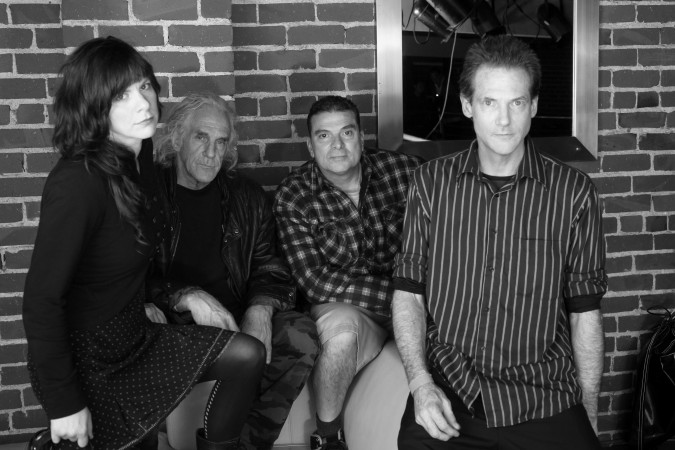
Rachel Thoele, Ted Falconi, Steve DePace and Bruce Loose of Flipper, March 2, 2012, Oakland, California. Photo by Kevin Warnock.
I have photographed bands since I was in college. Usually the bands were small punk rock bands few had heard of.
Sometimes the bands had a recording or two out.
I even did a shoot for an album jacket for Sluglords, for my friend Willy Lipat, the bass guitar player for Sluglords.
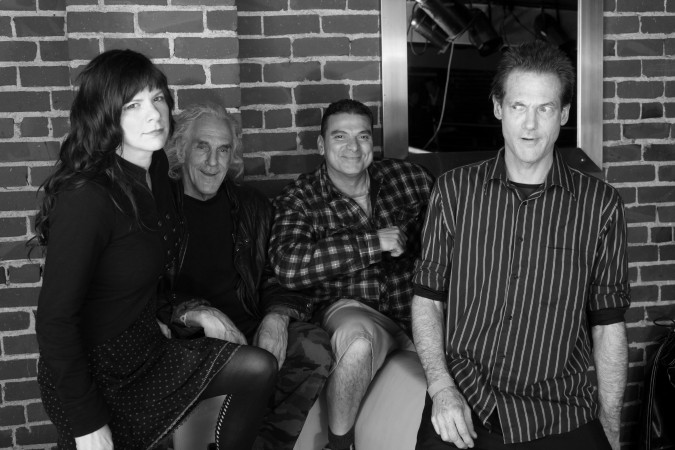
Rachel Thoele, Ted Falconi, Steve DePace and Bruce Loose of Flipper, March 2, 2012, Oakland, California. Photo by Kevin Warnock.
I have never conducted a formal photo session with a famous band until earlier this month, when I photographed the groundbreaking punk band known as Flipper.
I was fortunate to have the opportunity to photograph Flipper because I am friends with the drummer, Steve DePace.
DePace handles publicity and booking for Flipper, and he asked me in February if I could come to their concert at The New Parish on March 2, 2012 and photograph the band before their show. I agreed, and I am really glad I agreed.
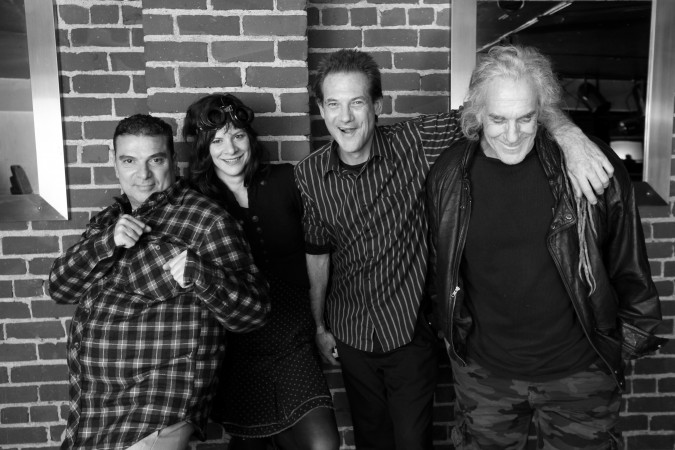
Steve DePace, Rachel Thoele, Bruce Loose and Ted Falconi of Flipper, March 2, 2012, Oakland, California. Photo by Kevin Warnock.
I wrote about Flipper on February 25, 2012 to help promote this concert. The show itself was outstanding, and I hope to write a review later. I shot high definition video at the show which turned out well. I brought a tripod and set up in the balcony with a clear shot of the stage. I got some great stills of the band performing, including an exceptional shot of guitarist Falconi in action.

Steve DePace, Rachel Thoele, Bruce Loose and Ted Falconi of Flipper, March 2, 2012, Oakland, California. Photo by Kevin Warnock.
Here are my favorite eight shots from my nine minute photoshoot March 2, 2012 with Flipper. The band was also formally interviewed before their show. I didn’t want to take too much time, and I felt that after nine minutes that I had some good results. I could have gone on much longer, but I wanted to make a good impression by being decisive and quick. I hope that Flipper will recommend me to other bands they know, as I really enjoy photographing groups of people. I gave a lot of directions on this shoot — including telling people where to sit, stand and where to look. I didn’t tell Rachel Thoele, the bassist, to kick singer Bruce Loose in the head. They were joking around which was great. You would think I knew all these members in advance from how relaxed everyone looks, but I just met Thoele, Loose and guitar player Ted Falconi a few minutes prior to the shoot.
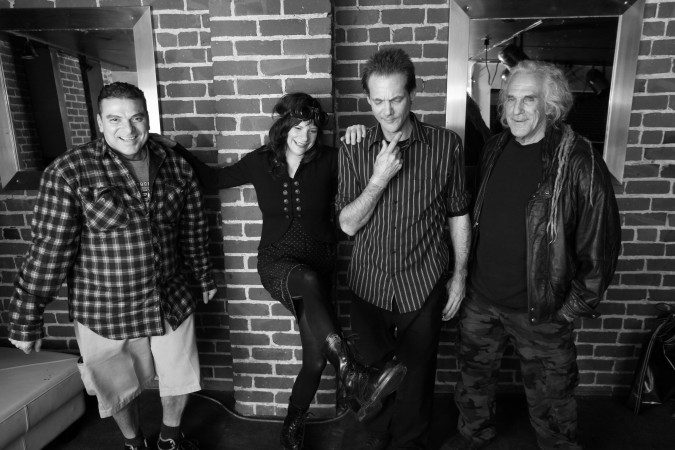
Steve DePace, Rachel Thoele, Bruce Loose and Ted Falconi of Flipper, March 2, 2012, Oakland, California. Photo by Kevin Warnock.
Loose only pretends to be hurt from his kick in the head. He grimaced for a solid ten seconds like he was really injured — then he broke into laughter and stood up straight and was fine, as you can see in the final shot. He had me fooled.
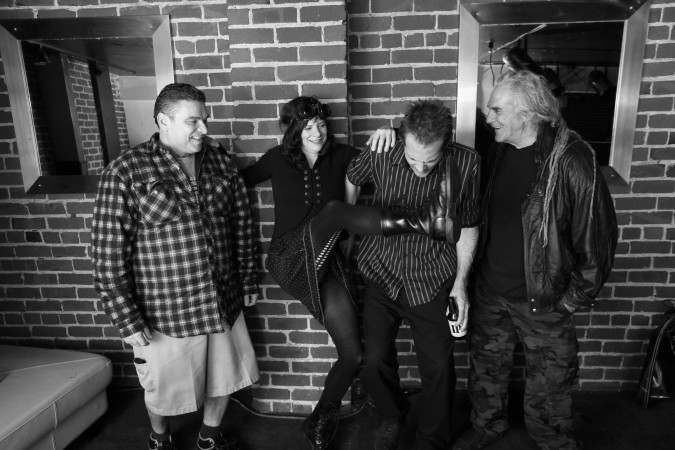
Steve DePace, Rachel Thoele, Bruce Loose and Ted Falconi of Flipper, March 2, 2012, Oakland, California. Photo by Kevin Warnock.
All the members of Flipper were exceptionally nice to me. Ted Falcone even talked with me as I was putting away my lighting equipment. He asked me about LED photography lights and what I thought of them. I was impressed by his knowledge of the subject.
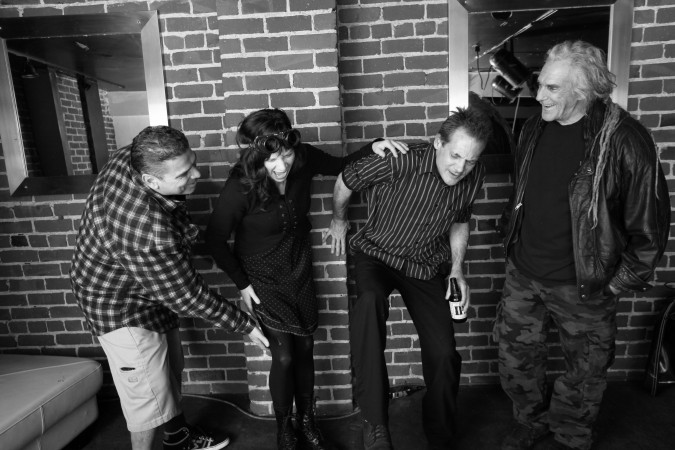
Steve DePace, Rachel Thoele, Bruce Loose and Ted Falconi of Flipper, March 2, 2012, Oakland, California. Photo by Kevin Warnock.
I shot these pictures with a Canon 5D Mark II camera. These pictures may be seen at full size if you click on them twice. Full size is 21 megapixels — huge — bigger than your screen.
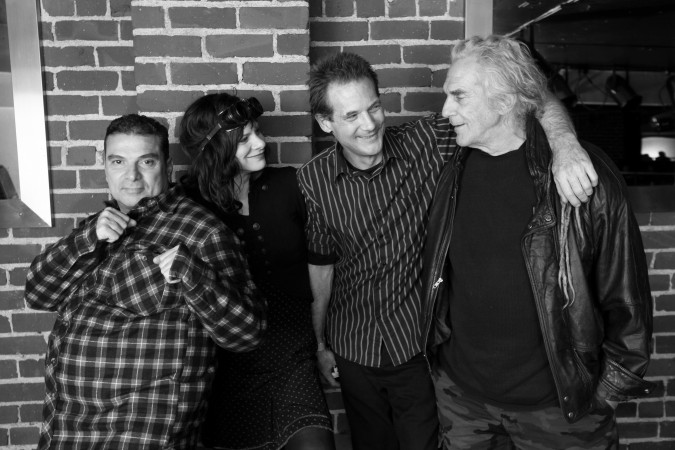
Steve DePace, Rachel Thoele, Bruce Loose and Ted Falconi of Flipper, March 2, 2012, Oakland, California. Photo by Kevin Warnock.
Flipper leaves soon for a European tour. They will be flying, not swimming.
Here are the tour dates:
- April 5, 2012 The Croft — Bristol, UK
- April 6, 2012 Rescue Rooms — Nottingham, UK
- April 7, 2012 The Duchess — York, UK
- April 8, 2012 Stereo — Glasgow, UK
- April 10, 2012 XOYO — London, UK
- April 12, 2012 De Klinker Club — Aarschot, Belgium
- April 13, 2012 Sonic Protest Festival — Paris, France
- April 14, 2012 L’Epicerie Moderne — Lyon, France
- April 16, 2012 Nachtleben — Frankfurt, Germany
- April 17, 2012 Knust — Hamburg, Germany
- April 18, 2012 Stengade
- April 20, 2012 Arena — Vienna, Austria
- April 21, 2012 Latte piu’ Live — Brescia, Italy
- April 22, 2012 Rössli — Bern, Switzerland
- April 24, 2012 Wild At Heart — Berlin, Germany
- April 25, 2012 Club Vaudeville — Lindau, Germany
- April 26, 2012 LVC — Leiden, The Netherlands
I got this list from the Flipper official website. I added the hyperlinks by performing Google searches for the names of the venues.
Before you book a trip to that venue, please check to be sure I got the link right by making sure you can find Flipper listed on that site for that day. The sites all looked like music venues, but I didn’t take the time to try to buy tickets to make sure I found the correct venue.
Have an MBA and an idea? Looking for a technical co-founder to build it and join your unfunded startup for equity alone?
One of my highlights each month is serving as a mentor for the Haas Founders group.
Haas Founders is a group for Haas School of Business graduates from the University of California at Berkeley. It’s an invitation only group, but if you graduated from Haas you are quite likely to receive an invitation if you are a founder or co-founder of a startup company.
Another way in is to have a meaningful connection to the Haas School. That’s how I became a member. I have been a judge for the Berkeley Startup Competition from about 2004 through 2011.
Finally, all Haas graduates can buy their way in by agreeing to pay for the food and drinks. This allows service providers like bankers, investors and accountants to attend. Such service providers can meet ambitious startup founders that sometimes turn into clients.
I write the above to introduce you to the Haas Founders meeting. There is a Facebook page and a Twitter account for Haas Founders. Michael Berolzheimer moderates and organizes the Haas Founders meetings. Berolzheimer runs the genesis-stage venture firm Bee Partners which, according to his firm’s web site, pollinates visionary entrepreneurs with financial, human and social capital. Kishore Lakshminarayanan helps Berolzheimer set up the meetings, which take place at different venues each month, in the East Bay, South Bay and San Francisco, California USA. I met Berolzheimer in 2007, before he took on the responsibility for Haas Founders from the previous organizer, Mat Fogarty, CEO of Crowdcast.
Haas Founders has established a group on the professional social networking site Linked In. As of this morning there are 86 members. I believe the group is seeking new members, so if you fit the requirements, please introduce yourself to Michael Berolzheimer.
Haas Founders can be thought of as a board of directors like support group for startup founders, where no issues are off limits for discussion. That makes Haas Founders one of the most compelling meetings I’ve had the good fortune to attend.
I have attended the Haas Founders meetings since about 2005. Individual meetings are limited to 20 attendees.
This open forum for frank talk is made possible because attendees are asked to keep the the conversations confidential. To my knowledge, there has never been a meaningful breach of this rule. I think that’s a reflection of the trustworthiness and integrity of Haas students and graduates.
Given this secrecy, how can I write a blog post about Haas Founders?
Well, I am not going to discuss confidential information. The advice I am going to give is my own. I gave this advice to a participant at the most recent meeting March 6, 2012 in San Francisco.
I am not breaking confidentiality by repeating what I said that day because I have given this same advice many times without any restriction of confidentiality. It’s already public information. Problem averted. I ran this post by Berolzheimer before publishing it, as I want to be extra careful so as to not be uninvited to future meetings.
I decided to write this post because the issue I am going to talk about comes up so frequently that I have spent hours and hours answering this question over the years.
The question and answer are as follows:
Q: I am a non-technical founder and I have thought of a business idea that requires something technical be built. How do I find a talented technical co-founder to join my company for equity only to build my vision for me?
A: Forget it!
You can’t find a talented technical co-founder to join your unfunded idea stage company for equity only.
There are rare exceptions, but you can not count on them and should not consider counting on them.
One solution is to think of and pursue a business idea that you can implement with only the skills you have already. Here are three companies that I suspect began with little computer programming, for example:
- Become a mushroom farmer.
- Start a fair trade import company.
- Start a men’s fashion manufacturing company.
The smart people I suggest this answer to don’t quickly embrace my advice. That’s understandable. They are in love with their vision and they want to pursue that vision right now. They don’t want to hunt for a technically simpler business idea. They don’t want to learn the technical skills necessary to develop their original idea. They want a savior, a Steve Wozniak, to fall from the sky to do the real work of making a viable product. Usually such non-technical founders also want to reserve more of the company equity for themselves than for this savior, because they thought of the idea. If there is to be an equity disparity, I suggest it be weighted toward the technical contributors who make the product happen, not the non-technical people who think up the idea.
What non technical founders fail to appreciate is that talented technical individuals with the grit to want to start a company are in high demand. They are like supermodels in their desireability. A lot of people are asking them for dates. A lot of these suitors have lots of money to woo them with.
Why would a supermodel date a founder with no money when there is a line of suitors with six, seven or eight figure stacks of money at their side ready to spend?
The answer is supermodels don’t date broke founders.
Supermodels don’t hook up with unfunded MBAs that have a cool idea.
The perhaps sad truth is that MBAs are not held in high regard by many technical experts. This is not a comment on Berkeley MBAs, but on all MBAs. Of course, technical experts desperately need business experts at some point, as exits are rare for companies filled with only technical experts. I am not taking a stand on which type of person is more valuable because they are both vital. What I am saying is the technical people generally perceive that MBAs are not that important. If that’s the perception, then how can an MBA recruit a technical person without money?
There are millions of cool ideas to pursue at any moment. That’s always been the case and that will always be the case.
Talented technical people know they are in demand. They have recruiters calling them telling them so all the time. They read TechCrunch, VentureBeat and GigaOm. They know the technology world is in the middle of a full fledged boom right now. So only 2nd, 3rd, 4th and 5th rate technical people will agree to an equity only founder position with a non-technical sole co-founder.
The only practical exception is if you’ve already been friends with the person for years and they know your work and respect it. So classmates graduating together can get together and start a company, with some founders being non technical and some being technical.
But if you’re looking for a stranger to drop out of the sky to build your vision, you should forget it and focus on finding a simpler idea or on learning the technical skills yourself so you can build the first version of the product by yourself.
Yes, the product won’t likely have to polish of one created by a more seasoned expert, but it can be good enough. You only need it to be good enough to raise money that you can then use to pay a more skilled technical person to make an improved version.
I am not spouting off advice I read somewhere or heard somewhere — I know what I am talking about. Pardon me while I now go into extreme detail to convince you that I do know what I am talking about. What follows may seem like too much, but I have spent dozens and dozens of hours trying to beat this lesson into the heads of very smart non-technical company founders. I feel I need to pull out all the stops here to convince the skeptical that I am right.
I know it’s smart to learn to program because this is what I did to take my startup Hotpaper.com, Inc. from a USD $10,000 investment when I had almost no applicable skills through to a USD $10,000,000+ sale to a public company just six years later.
This is news I’ve written about more than once. But I haven’t described the grueling early work I put in that made this ‘quick success’ possible.
When I started Hotpaper, I was a minicomputer programmer. A Digital Equipment Coporation VAX minicomputer running Open VMS. There was nothing miniature about this computer. It filled an entire raised-floor water-cooled computer room and served 1,000 users in five offices in two US states. I believe it cost more than USD $12,000,000. Back then a 9 gigabyte disk drive cost USD $250,000. I saw the invoices and recall calculating the price per gigabyte.
When I started Hotpaper my only experience programming a PC was writing rudimentary DOS batch files. One can still write these for Windows, to run at a command window prompt. You can do amazing things with batch files, but you can’t write serious client-server or web applications with them. I had to learn to program graphical Microsoft Windows applications, and I had only used DOS on a PC up until that point. I had played for a few hours with a copy of Windows 3.1, but that was the extent of my experience with Windows. The one machine my employer had that ran Windows was so slow (Intel 386 with perhaps 1 megabyte of memory) that when you pressed a letter in a word processor (Ami Pro), there was a lag of about 1 full second before the character would show up on screen. It was pathetic.
I immediately bought a Hewlett Packard Pentium 60 Mhz computer with 4 megabytes of RAM and Windows 3.1 for Workgroups. I added Microsoft Office, which came on 30+ 3 1/2″ floppy disks, not a CD-ROM. This was a Pentium, not a Pentium II, III or IV. In fact, it was the slowest Pentium chip ever sold. But this was the fastest computer I had ever used. I still have it, in storage.
I all but shut myself off from the world for two years with hundreds of dollars of technical books, a 28.8K modem and a telephone. I taught myself to be an event driven computer programmer. Event driven programming is much different from the procedural programming I had done to program the huge VAX system run by my employer at the time, Cooley LLP. Yes, I knew how to program a little bit on a VAX, but Windows is so different that it’s almost as if I was learning to program from scratch.
Thankfully, Microsoft was not yet the market leader in word processing in 1994 since WordPerfect for DOS still dominated, so Microsoft tried very hard to persuade developers to embrace their Word word processing software. They offered free telephone technical support for programming problems, provided you paid for the phone call. There were no unlimited business phone lines back then, so my office phone bill was perhaps USD $100 a month due to all my calls to Microsoft — hours and hours of calls per month. I owe Microsoft so much for those calls, as they helped me to solve every problem I ever encountered. Thank you Microsoft.
Eventually Microsoft overnight switched from free technical support calls to USD $55.00 per incident technical support calls, and I had to stop calling them. But that was a couple of years later, and I had already gotten to be proficient by then, and I could get my questions answered for free on their well run newsgroups. By that point, Word and Office were the market leaders, and they didn’t need to try so hard to make developers embrace their tools.
I worked hard — really, really hard. I worked from about 10am to 10pm Monday through Saturday. On Sunday I wouldn’t come into the office until the mid afternoon, but I would still stay until 10pm or so. I did this from January 1995 through the end of 1996 or so, I believe. It took me that long to learn Windows programming reasonably well.
I didn’t know other software developers. There were no popular coworking spaces. Meetup didn’t exist. I was shy. But I was driven… really, powerfully and passionately driven. I had so little money I was living in a tiny studio apartment on Mason Street near Bush Street in San Francisco, California USA. My rent was USD $625 a month including utilities. I only owned one computer, so I could not work at home. I was at the office a lot, and it was just a seven minute walk to get there. I became really good friends with my office mates the late Stan Pasternak and patent attorney Robert Hill. I have such fond memories of that time.
Was the code I produced great? No. Was it awful? No. Was it reliable? Yes. Was it understandable to others? Yes. Did it get used by others for meaningful projects? Yes. Did I raise money with it? Yes. Did I sell the company successfully by following this model? Yes. Can you do the same? I think so.
At Hotpaper, I had a customer from the day I bought a computer. I told them I could build what they asked for. I actually had never done so on Windows. I had to figure out how to program Windows because I had a paying customer that demanded a Windows client-server based solution. They were paying me thousands so I had to deliver. I didn’t study for two years and then start to look for a client. I got the client based on my past reputation as a VAX programmer and then faked it until I made it.
It turns out that first project failed and the client never used my work or the work of any custom software developer.
They just bought an off the shelf application and conformed to its way of doing things.
But that’s irrelevant in the end. I got paid USD $30,000. I worked hard. The client made the best decision, for they should never have hired me or any developer when an off the shelf package was available for much less than having custom software written. I learned a lot, kept the rights to what I had built but did not get used, and I used that for the basis for what I then turned around and sold to Coca-Cola and the United States Department of Commerce, where it did get used on an enterprise scale.
Today it’s easier than ever to become a programmer. There are so many online tutorials like those from Codecademy. There are so many hacker co-working spaces like Hacker Dojo where you can base your new venture. You can work there as many hours as you can keep your eyes open, and there are smart people around much of the time to get help from.
Today all the software you need to do almost any project is free. That wasn’t the case in 1995, when now standard building blocks like MySQL hadn’t been popularized yet.
I have seen smart graduates spin their wheels for months or years trying to recruit a magical co-founder to build their product. How much better it would be for these people to sit down at Hacker Dojo and focus their considerable brain power on learning to program software directly. Even if the entire result is eventually rewritten later by someone more skilled, they would be better off than if they somehow found the mythical co-founder.
For once you know how to program in any language, you will be able to talk about and think about technical problems far more effectively than you can as a non programmer. It will be far more difficult for people to confuse, mislead or bamboozle you. You will be able to hire better programmers who will respect you more. You will be able to tell programmers what to attempt with more clarity and conviction because you know at least something about their world.
You will have insight into a world that’s richly diverse and totally fascinating. Your life will improve even if you never make a penny from your venture.
Programming is not easy. It can be absurdly complicated and exasperating at times. That’s why new college graduates who know little about the real world of programming can still command pay approaching USD $100,000 to start.
I am just one modestly successful entrepreneur.
Before you become a programmer, ask some technical startup founders you trust and see if they agree with what I’ve written here. Remember, Steve Jobs got lucky with Steve Wozniak. Silicon Valley was a sleepy place back then compared to today. Go make your own luck by developing your technical skills. If you have an MBA, you presumably spent four years to get an undergraduate degree and two years to get a business degree. Spend two more years to become a programmer. Doctors spend more time studying before they complete their education, so view eight years of study as normal, not crazy or silly.
I love programming, and I am extremely grateful I spent those grueling early years just powering through the books and road blocks to learn to program.
I feel I can do nearly anything I can dream up.
That’s a powerful feeling I wouldn’t give up for anything.
Please subscribe to this blog by leaving your email address in the upper right corner. Please friend or subscribe to me on Facebook. Please follow me on Twitter.
It pays to challenge the assessed value of your home
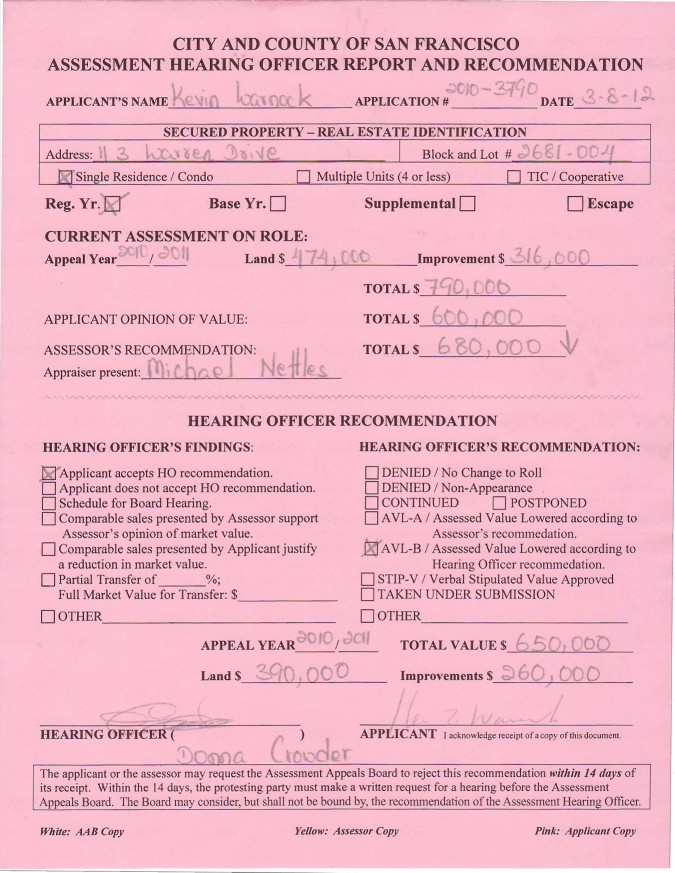
City and County of San Francisco Assessment Hearing Officer Report and Recommendation for Kevin Warnock, March 8 2012
On Thursday, March 8, 2012, despite my having a bad cold and feeling awful, I had a financially remunerative day.
I attended my assessment appeals hearing for my house. I had applied for a reduction in the assessed value in 2010, but because so many San Francisco property owners are also appealing their assessments, it took until 2012 to get a meeting with a hearing officer.
My property tax in 2010 was just over USD $10,000 if I recall correctly. The current assessment on role above shows a value of just before the hearing of USD $790,000. That value itself is reduced from the original 2010 assessment value. It was reduced at my request via an informal yet written request I made in 2010.
Thanks to declining home prices due to the Great Recession, my 2010 taxes declined to $7,616.70!
My new assessed value as a result of my formal hearing on Thursday is USD $650,000. So I got two meaningful reductions — once in response to an informal request where I didn’t have to appear in person, and the other where I did have to appear in person and present evidence. I presented a full appraisal I paid Christian Koenig of Koenig Appraisal USD $350 for. That was money well spent. Donna Crowder was the hearing officer and Garry Michael Nettles, Jr. was on hand representing the San Francisco Assessor’s office.
I was impressed with how well Nettles had researched the comparable sales my appraiser relied on. In one case the appraisal cited a fixer upper that sold for USD $595,000 but was professionally flipped for $935,000 soon after. I am friendly with the developer that did the flipping, and I saw the result, which was astonishing. My house is not in ready to be flipped condition, so the original comp was more fair than the flipped sales price. I had asked for my appraised value to be reduced to USD $600,000, but got only USD $650,000. Frankly, I think the higher number is right on target, as the comps were for houses not as nice as my house is.
Crowder and Nettles discussed their views in front of me, and they ran calculations on their large plug-in calculators. The hearing took about 15 minutes. I was impressed with how thoughtful and smart both Crowder and Nettles are, and I think they arrived at a number that is neither too high or too low.
I am pleased and relieved.
This happy result is something of a surprise, given how critical I was of the Assessor-Recorder’s office the last time I wrote about it on this blog. In brief, the office is so overwhelmed that they routinely hold customer checks for services for months before cashing them. When I was there paying in 2011 I used cash since the office had held my 2010 check for months before they cashed it. I complained and was told they routinely hold checks. I believed them because I saw checks sitting in the open around their office, including on the counter where I was standing. I could have copied the check numbers and drained the accounts if I were a bad guy. I was appalled and I wrote a critical piece about my findings. I don’t think my piece hurt me at the hearing, which is a relief. I looked in the Assessor-Recorder’s office on Thursday, and I didn’t see any personal checks laying around for the public to view, so maybe my earlier blog post was discovered by those in authority and changes were made. I relayed this story of holding checks to a teller at San Francisco Fire Credit Union, where I hold my checking accounts, and learned that they were familiar with San Francisco holding checks so long that they become impossible to cash due to how old they are. If a random teller knows about this issue, it must be pervasive. I hope my blog post about this was headed. This is an issue of real importance because holding checks causes people to overdraw their accounts, which results in big overdraft fees, which is a drain on society.
My tax rate is 1.1718%.
The Zillow home value website shows my house value as of March 8, 2012 to be USD $756,000. When I got married in 2008, the Zillow value was about USD $1,050,000. When I got divorced in December 2011, the Zillow value was far lower. Even the far lower Zillow value today is far higher than my new assessed value.
Since I plan to stay in this house indefinitely, I am thrilled the value is so low.
I paid USD $740,500 in 2001 or 2002 when I bought the house, which was far higher than the asking price of USD $619,000.
I had to outbid 19 other buyers to win this house, but it’s a great house with a spectacular view and copious free street parking for guests and housemates.
I was told to expect my refund check from San Francisco within six to eight months, but I won’t hold my breath, since one of the homeowners in front of me at Thursday’s public hearing said he had won an assessment reduction for 2009 but still hasn’t received his check, roughly a year after his hearing for that year.
Ellen Campesinos! says that female rock musicians rarely get laid on tour
I have been thinking about the life of musicians. I just finished writing a post about the band Peligro.
Peligro is D.H. Peligro’s current band. I’ve known D.H. for over twenty years, having met him through my good friend from high school Willy Lipat that was in a band with him.
Peligro always had gorgeous models or model types around. I was a painfully shy photography student that hoped to become a fashion photographer so I could hang out with beautiful women. I was envious.
I imagined that rock stars got a lot of sex while on tour. I still imagine that.
Thus, it was with surprise that I learned touring is not a sex fest — at least not for female rock musicians.
Ellen Campesinos! of the indie-pop collection Los Campesinos! (sic) wrote a powerful piece for Nerve magazine that shattered my illusion about the sex life of traveling musicians. Before I get into what Ellen wrote about road sex, have a look at what WikiPediA has to say about her band, for context:
“Los Campesinos! are a seven piece indie pop band from Cardiff, Wales, formed in early 2006 at Cardiff University. Although the band formed in Wales, none of its members are Welsh. They released their debut album, Hold on Now, Youngster…, in February 2008 and followed this up by releasing a record titled We Are Beautiful, We Are Doomed, in October that year. Whilst many consider it to be an album due to its length, the band have always referred to it as a ‘record’ or EEP (Extended EP)[1] due to contractual and artistic reasons. Their second official album, entitled Romance Is Boring, was released on 1 February 2010. Their fourth full-length release, Hello Sadness was released on 14 November 2011. The band has announced US & UK tour dates for 2012.[2]“
All of the members use the word ‘Campesinos!’ as their surname, even though the members are not related. The exclamation mark is part of the last name. The real name of Ellen Campesinos! is Ellen Waddell, and I will refer to her as Ellen in this blog post, even though I usually refer to people by their last names once I first identify them by first and last name. It’s too confusing to use Ellen’s last name when all her band mates use the same last name.
Ellen quickly catches the reader’s attention in her Nerve article with this eye opening paragraph:
“Neko Case recently claimed via Twitter that “Ladies in bands don’t get ANY action,” and as a female musician with a frustrated libido, I can sympathize. I’ve been playing bass in a touring band for five years, and I’ve had intimate relations on the road four times. (I class intimate relations as third-base-plus, but even if I counted kissing and over-the-clothes fumbling, it would still be a pretty low number.) I’m lucky enough to be in a job where I get to tour the world and meet interesting people, but in my experience, musicians — especially females — get a lot less then you’d imagine.”
Ellen colorfully boils sex on the road down to these four points:
- Time and space are limited on tour since tour vans and buses are cramped and really are there for the band mates to work in, not play in.
- It is awkward and unsatisfying to seduce a fan from the audience because fans put musicians on uncomfortable pedestals.
- It creates workplace stress to seduce the musicians from bands touring with your band.
- Friends of fans that are attending the show out of their support for their friend rather than their knowledge of the band make the best targets for lustful connections.
Why am I writing about Ellen’s provocative story?
Ellen is an actual rock star. Ellen is beautiful. Ellen is young. Ellen writes well (she studied journalism). Ellen is a founding member of a well regarded band that tours the world. I would not expect that she would have any trouble in the sex on tour department. I would expect that she could point out to a roadie a guy that she is interested in, and that roadie could do the tough work of approaching the guy and explaining a deal of quick sex with Ellen in exchange for not stalking her or trying to attach long strings to her. I would estimate the success rate of such an approach would be around 90% or greater.

Ellen Campesinos! playing bass guitar. Photo from http://blogs.dallasobserver.com/dc9/2009/01/the_indie-verse_is_streaming_o.php
But Ellen is shy, like I am. And shyness just sucks. It has messed up a good part of my life. I am absolutely determined to not let it mess up the rest of my life, and by writing about sex and Ellen, I am drawing your specific attention to a subject dear to my heart these days.
When you really get down to it, I left UCLA for Brooks Institute because I was shy. UCLA is a big school, and the second year, when I did not get a slot to live in the dormatories, I had to live about a mile off campus in a soulless apartment building without any other students. Most of my classes had 500 people in them. There were no cell phones or texting. It was difficult to ever see the same students even twice.
Friendships were difficult to form.
Brooks at the time seemed so much better. Classes were small, at around 20 students, and I made and kept a lot of friends.
Trading the opportunity at UCLA for friendship at Brooks is not a trade I should have made.
I deeply regret leaving UCLA.
I regret it so much that I am seriously considering returning, especially since I recently learned I do not have to go through the admissions process of a new student, because I properly withdrew and I have the original stamped paperwork in my fire proof safe. I have learned that all I need to do is fill out a one page form, send in my Brooks transcripts and I am in.
I have lost most of my shyness, but not all of it.
I still am hesitant approaching women for dates. I can approach them painlessly for anything else, including to model for me. I can handle a roomful of women. I can direct one or more women in front of the camera with confidence and authority.
But when I ask a woman on a date, I feel vulnerable because I am signaling to her that I find her sexually desirable. I am in effect telling her that I want to have sex with her, even if I am a perfect gentleman asking her for coffee with her grandmother. I should not feel awkward. I feel less awkward about asking women for dates now than at any point in my life, so I am making progress. But for me to be most effective, I should dispatch all fear and nervousness, for I fear that women pick up on that and are less likely to accept an invitation.
I thank my lucky stars that I have taken care of myself and am only 10 pounds heavier than I was at age 16 when I got my driver license (155 then and 165 this morning, in pounds). I feel attractive and sexy which I think women are also good at decoding.
I will conclude with a crazy story from my youth.
I used to love DNA Lounge. It’s still there, and it’s still cool, from what I can tell from afar. It’s open late. When I was a regular, it closed at 4am.
I had been there dancing by myself at about 3am, and found myself dancing with a solo woman, as often happened. We danced together until closing, but didn’t exchange numbers or keep in touch. It was fun but she was one of many women that I had ‘met’ and danced with late at night. She did tell me a bit about herself, including that she worked at Levi Strauss.
About two months later I was at DNA for a concert. The bar was in the center of the main room, about 15 feet from the stage. I was standing facing the stage and leaning against the bar. It was extremely loud because the band was playing.
A woman slid in next to me at the packed bar, to my left. I glanced briefly at her and it was the woman from the 3am dancing the other month. We hadn’t kissed or anything when we met, but I thought she was very attractive. At the bar at the concert, I wrapped my arm around her shoulder and she immediately, within five seconds, leaned in towards me as if we were a couple. We watched the show like this for at least ten minutes, not speaking, as that was essentially impossible since the huge speaker columns were just 15 feet away.
Live music at DNA is much louder than the recorded music the DJ plays.
At this point, it was around midnight. Without worrying about anything, I leaned to the left and kissed this woman. She kissed back. Soon, we were upstairs on one of the couches making out. This is before the days of bottle service where the nightclubs charge big dollars to sit down.
After about an hour of making out, still comparatively early, I asked her if she still worked at Levi Strauss. She replied that she didn’t and had never worked there! This woman was a complete stranger, and I had not danced with her for an hour some two months earlier!
She was a student at UC Berkeley.
I still wonder what she thought of me being so bold with her that I put my arm around her and start kissing her without even saying hello or asking her name.
I have never done that again, but I sometimes wish I could. No, I don’t want to kiss women I don’t know, but I would like to be able to be so confident that I can attract a woman so powerfully that she would agree to kiss me, even if we never did so in such haste.
Ellen of Los Campesinos!, talk to strangers after your rock shows. Don’t wait for them to get up the courage to say something. You’ll be waiting a long time most of the time, as a guy alone at the bar upon seeing a hot band member is extremely unlikely to approach you because he’ll assume your boyfriend is going to be by your side any moment. You don’t look like the type to want to have casual flings either, which particularly works against you.
I am not interested in picking up women in nightclubs or bars, and I haven’t been out dancing by myself since 2005. The woman I am looking for is not likely in a nightclub or bar in any event, so I don’t feel that I am missing anything. But I did want to share this outlandish story from my past as I think there is much to be learned from it.
You might be wondering why I write this blog. I don’t make money from it. It costs me a lot of time and a little bit of money.
What I am doing here is making my own luck.
The women I want to meet are much more likely to be reading this blog than to be looking for me in some dark nightclub at 3am.
By sharing my life, dreams, secrets, ambitions and ideas, I am also setting the stage for my next marriage and starting a family with children, since I am single now.
Stay posted to learn how my life progresses.
You may subscribe by leaving your email address in the upper right corner. I also encourage you to friend me on Facebook, where I post status updates for each blog post.
And if you’re a woman you think I might like after you’ve read a dozen or more of my blog posts, please introduce yourself to me, OK? Remember, I’m still a little shy.
